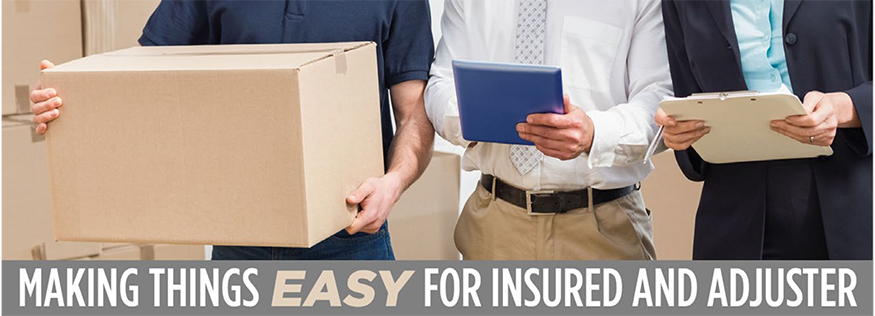24/7 Emergency Services
April 2018:

It has been our experience that each claims adjuster has a way of performing a job that is different from any other. Of course there are similarities, but each has preferences that are uniquely their own. Some will appear on the job, some won’t. Some will ask for meticulous site diaries, others don’t want to get bogged down in too much detail.
It is up to the observant contents manager to decide how best to interact with the various types of adjusters and to keep the lines of communication open.
A typical contents job manager will meet with the policy holder in the home or office where the assignment is taking place.
Together they will walk through the structure to best determine the scope of work and how to proceed. A large amount of digital photographs are taken, with the insured pointing out specific items and important needs (the photos serve to document the insured’s requests and concerns).
The contents manager will work directly with the adjuster to best determine the policy provisions and the scope of the work at hand. Some contractors will simply begin the work without having the opportunity of consulting with the adjuster. But we have found it more expedient (and far more logical) to submit a “pre-estimate,” have the adjusters make modifications based on their won experiences, their carrier’s policies and set reserves - then proceed with an agreement based on all these factors. This transparent approach serves to avoid misunderstandings and misinterpretations later down line.
The digital photos also serve as an inventory, documenting the pre pack out conditions of most of the items, then providing a “chain of custody” for pack out, transport, warehousing and cleaning of valued objects and documents.
The photos themselves are available to the adjuster, the homeowner/office manager and even to the insurance agent on the case. They even act as a “template” to show the frontline workers where everything started out, so the individual pieces can be returned to the exact spots from which they were originally removed.
Any of course we work closely with the structural team to provide a seamless and timely completion of each job.
We are also proud of the fact that other contractors who do not have a contents division or find that a contents job is too complex or too demanding on their resources are now assigning all or part of their contents work to us. Our code of excellence has become a hallmark both to other contractors and carriers alike.
2500 PALLETS
MOLD AND A JOB WELL DONE
Restoration and Remediation Magazine’s 4th Annual Case Study ContestWinner was a story about a warehouse assignment. The building itself was 111,159 square feet and needed roof repair after a severe rain and wind storm. The contractor on the case said that the size of the warehouse was several times the size of a Super Walmart.
Before the structural team could get to work, the contents pros had to figure out what to do with all the boxes and racks of stock. 2500 pallets of merchandise were non-salvageable and packed out - it took three semi-trucks running around the clock for two days just to get that part done. There was no other choice and the client was more concerned with what could be saved. The structural team worked hard and fast because the stock was composed of Halloween costumes, makeup, accessories, etc. Mold spores would destroy any chance to sell the remaining merchandise.
Somewhere between 50 and 60 workers were on site. Almost a dozen negative air scrubbers were used and artificial lights were strung throughout. The restoration pros found huge pockets of mold that were removed or remediated without contaminating any of the remaining stock. All the racks and racks of materials were saved.
The contest winner ended up charging about one tenth what another company had charged for a similar job with the same insured.
$45,000 LESS THAN ADJUSTER’S QUOTE
The contents pros have cleaned soot and smoke from flat painted walls, from tricky gloss walls, from brick and even textured wall paper, but few surfaces are more challenging than unfinished wood. Every splinter, every nook and cranny can be filled with smoke particulates. So when one company was faced with a whole house full of magnificent wood walls, ceilings and floors they had to get really creative.
In R & R Magazine the adjuster on the case said, “The cleaning of the house and restoration of the fire damage took less than four months and was approximately $45,000 less than what I had originally quoted.”
How did they do it? Well they “gutted” the basement (where the fire had started) and soda-blasted all the surfaces. Then they “washed” all surfaces (including 26 ft. High walls) with a special solution and power sprayers. The runoff was collected in a basin and the waste was pumped outdoors.
The adjuster added, “The insured and his wife were pleased with the complete restoration of the home and removal of the entire smoke odor.”
What many had considered to be a crazy scheme, proved to be just another in a long line of innovations by the contents professionals. And really, the job was so massive, the lines were blurred between contents and structural pros - this time they were one and the same!
ADJUSTERS AND AGENTS HIRE CONTENTS PROS
When some adjusters by-pass other contractors to hire us, it is usually with their bosses’ strong approval.
The reason is pretty simple - we are the “Yes Men” of the industry. When an insurance company’s office manager calls 5 restoration companies saying, “We have a painting that has been appraised at over $25,000. It was exposed to hot steam and now looks like the whole painting has cataracts - can any of your guys fix it?” And they all say, “No, sorry, we don’t do that sort of thing.” Then the 6th company they call is us and we say, “Sure! We are associated with one of the best art conservatories in the world,” They breathe a sigh of relief, hire us and when the art comes back in pre-loss condition, they remember us and don’t waste time and money trying to find someone else to say, “Yes.” They just by-pass everyone else and call us.
By the way, the $25,000 painting story actually happened. The conservatory restored it for $850, saving the insurance carrier over $24,000 on a single item. And guess what? The conservatory is in our “Million Dollar Data-base,” waiting for our call.
And when a moose head falls off the wall and breaks an antler, the adjusters call around trying to find a contents team who cal help and get a lot of “mp’s” until they call us. We send a cell phone image to the taxidermist in our database, she gives us a fair price in advance; we get your OK, ship it to her and have another check mark in the “win” column for us and the carrier.
We have contacts who help us restore a collection of fine china with a single plate or cup (instead of having to replace the whole set). We know where to get old mystery paperbacks to replace a waterlogged collection for pennies on the dollar.
We have antimicrobial solutions that can be used with workers still at their desks, students still in the classroom or families still in their home - so strong that they can kill MRSA, HIV, Norovirus, ect. But so human friendly that one spokesperson actually drank some just to prove he could!
We are not ordinary restoration professionals. We are specialists who get the job done. And that is why adjusters and agents by-pass those who can’t and come looking for us!
OPEN FOR BUSINESS IN 48 HOURS
The contents pros were faced with the aftermath of a fire that spread smoke and soot damage throughout a 60,000 square-foot manufacturing plant including a 9000 square-foot office area. We’ll tell you more about the office area in a future issue of contents solutions, but the major challenge faced that night ws that the company had a huge shipment due to go out the next day and now it smelled like the world’s largest ashtray!
The contents pros set up massive air scrubbers to help improve indoor air quality, then they backed in a 53 ft. Semi-trailer which was now a mobile remediation chamber. Once the doors were closed and sealed, ozone was pumped in and all the goods were processed, deodorized, sanitized and inspected.
The entire shipment was restored to pre-loss condition was on the road within 48 hours of the initial fire.










